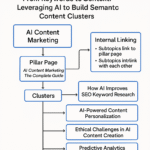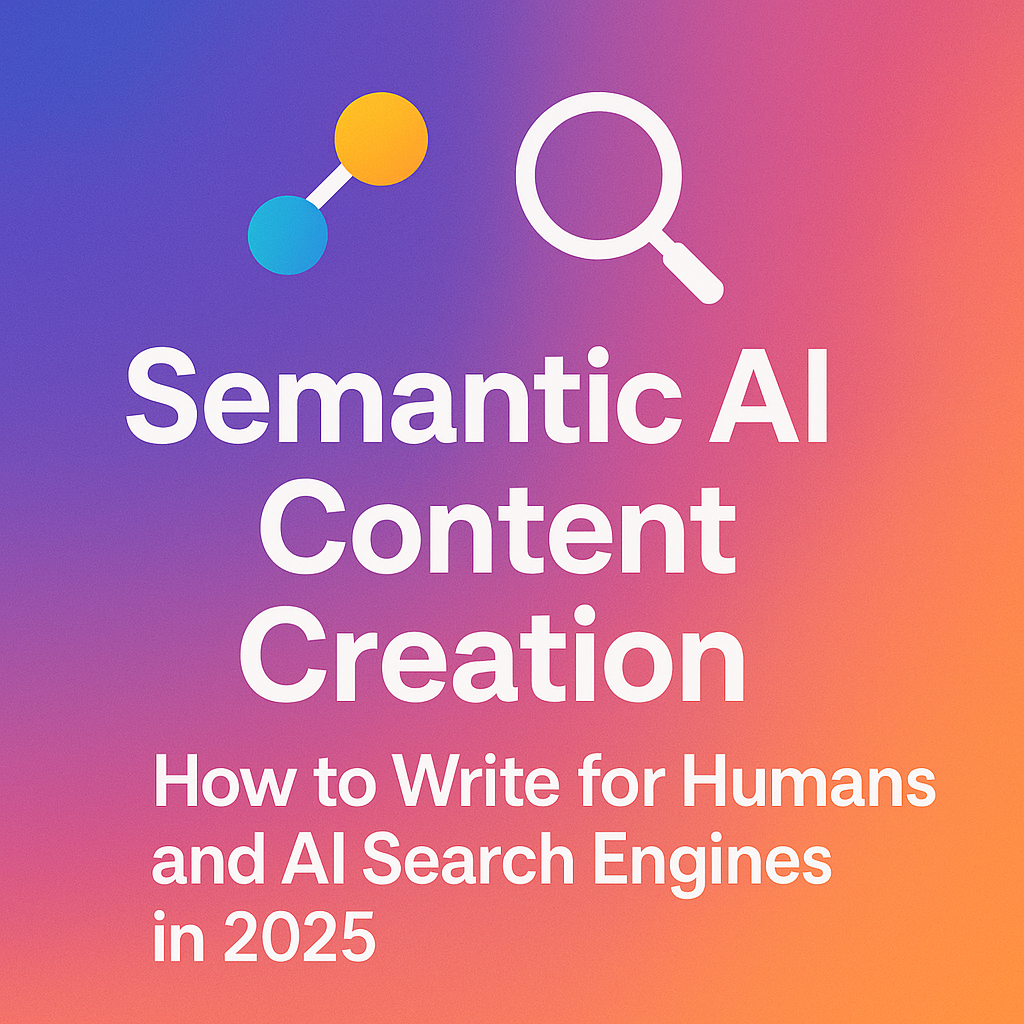Entity-Driven AI Content: The Complete Guide to Semantic SEO Success in 2025
- dino de wet
- 0 Comments
Entity-driven AI content represents a fundamental shift in how we approach content creation and search engine optimization. This methodology organizes information around entities (people, places, products, concepts) and their relationships, creating a web of interconnected knowledge that mirrors how both human cognition and artificial intelligence systems process information. This approach significantly enhances content visibility for AI search engines and Google’s algorithms by providing clear context, relevance signals, and authority markers that go far beyond traditional keyword-focused strategies.
Unlike conventional SEO approaches that rely primarily on keyword density and placement, entity-driven optimization structures content for semantic meaning. This enables deeper semantic search visibility and positions content to perform exceptionally well in natural language processing (NLP) environments, where search engines and AI systems seek to understand intent rather than simply match text strings.
Why Entities Form the Foundation of Modern Search Understanding
Entities serve as the fundamental building blocks of Google’s Knowledge Graph, a massive database that contains billions of facts about people, places, and things, along with the relationships between them. When search engines encounter content, they don’t just read words—they identify entities and map their connections to understand the broader context and meaning.
This entity-based understanding is crucial because search engines use these connections to determine which content provides the most accurate, comprehensive, and context-rich answers to user queries. In 2025, entity SEO has become absolutely critical for success in Semantic SEO, Answer Engine Optimisation (AEO), and Generative Engine Optimisation (GEO) because it aligns directly with how natural language processing (NLP) systems and AI-powered search interpretation functions work.
The evolution toward entity-driven search reflects a broader shift in how users interact with search engines. Modern searchers use conversational queries, voice search, and expect precise, contextual answers rather than lists of potentially relevant pages. Search engines have adapted by developing sophisticated entity recognition capabilities that can understand the nuanced relationships between concepts, enabling them to deliver more relevant and comprehensive results.
Core Elements of Entity-Driven Content Strategy
Primary vs. Secondary Entities: Building Content Hierarchy
Understanding the distinction between primary and secondary entities is crucial for effective content organization. Primary entities represent the main focus of your content—the central topic, product, service, or concept that your content directly addresses. For instance, if you’re writing about Semantic SEO, this becomes your primary entity around which all other content elements revolve.
Secondary entities provide essential supporting context that enriches the primary entity’s meaning and relevance. These might include related concepts like structured data, Google SGE, natural language processing, Knowledge Graph, and search intent. The strategic inclusion and natural integration of both primary and secondary entities creates stronger semantic relationships that search engines can easily identify and value.
The key to successful entity implementation lies in maintaining natural, logical connections between these entities. Rather than forcing unrelated concepts together, focus on building authentic relationships that genuinely enhance the reader’s understanding of the primary topic.
Entity Relationships & Co-Occurrences: Creating Semantic Connections
Search engines have become increasingly sophisticated at recognizing and valuing content where related entities appear together in meaningful ways. These co-occurrences signal to search algorithms that your content comprehensively covers a topic and understands the interconnected nature of related concepts.
Effective entity relationships follow natural patterns of association. For example:
- Semantic SEO → improves → AI search visibility
- Entity-driven content → enhances → topical authority
- Knowledge Graph → supports → entity recognition
These relationships should emerge organically from your content rather than being artificially inserted. When entities appear together in contextually appropriate ways, search engines interpret this as a strong signal of content quality and topical expertise.
Topical Maps & Content Clusters: Organizing Entity Ecosystems
Topical maps provide a visual framework for organizing related entities and demonstrating their interconnections. These maps serve as blueprints for comprehensive content strategies that cover entire topic ecosystems rather than isolated subjects. By mapping entity relationships, content creators can identify gaps in their coverage and opportunities for creating supporting content that strengthens overall topical authority.
This approach naturally supports content siloing, a strategy that groups related content together to demonstrate expertise in specific subject areas. Well-executed content silos improve internal linking structures, distribute page authority more effectively, and signal to search engines that your site is a comprehensive resource for particular topics.
Content clusters built around entity relationships also support the development of pillar pages and cluster content, where a comprehensive pillar page covers a broad topic extensively, while cluster content addresses specific subtopics in detail, all connected through strategic internal linking and entity associations.
Leveraging AI Tools for Entity-Rich Content Development
Entity Extraction with AI-Powered Tools
Modern AI tools have revolutionized the process of identifying and incorporating relevant entities into content. Platforms like Frase.io, NeuronWriter, InLinks, and MarketMuse can analyze top-ranking pages for any given topic and extract the key entities that contribute to their search success.
These tools perform sophisticated analysis of competitor content, identifying not just obvious primary entities but also subtle secondary entities and supporting concepts that enhance topical comprehensiveness. By understanding which entities appear most frequently in successful content, you can ensure your own content includes the necessary semantic elements for competitive visibility.
Advanced entity extraction goes beyond simple keyword identification to understand semantic relationships, entity hierarchies, and contextual relevance. This enables content creators to build more sophisticated, comprehensive content that addresses topics with the depth and breadth that both search engines and users expect.
Generating Entity-Focused Content Outlines
AI tools excel at creating detailed content outlines that incorporate entity hierarchies and ensure comprehensive topic coverage. These AI-generated outlines can map the relationships between primary and secondary entities while suggesting logical content flow that maintains semantic coherence.
An effective entity-focused outline will organize content sections around related entity clusters, ensuring that each major section addresses core concepts while naturally incorporating supporting entities. This approach creates content that feels comprehensive and authoritative while maintaining the semantic clarity that search engines value.
AI Drafts Combined with Human Semantic Refinement
While AI tools provide excellent starting points and can significantly accelerate content creation, the most effective entity-driven content combines AI efficiency with human expertise. AI assists with speed, research, and initial entity identification, but human editors ensure semantic depth, accuracy, and the authority signals necessary for E-E-A-T (Experience, Expertise, Authoritativeness, Trustworthiness) compliance.
Human refinement focuses on ensuring that entity relationships feel natural, that content provides genuine value beyond simple entity inclusion, and that the overall semantic structure supports both user understanding and search engine interpretation. This hybrid approach maximizes both efficiency and quality.
Structuring Content for Maximum AI Readability and User Engagement
Content Architecture for Semantic Clarity
Effective entity-driven content follows specific structural principles that enhance both AI readability and user experience. Content should be organized into logical chunks with clear heading vectors that immediately signal the intent and focus of each section.
Each section should begin by answering the query directly, providing immediate value to both users and AI systems that scan for quick answers. After delivering the direct answer, content can expand with supporting examples, detailed explanations, and contextual information that demonstrates comprehensive understanding.
This structure supports multiple search behaviors, from users seeking quick answers to those requiring comprehensive information. It also aligns with how AI systems process and extract information for featured snippets, answer boxes, and other prominent search features.
Formatting for Enhanced Semantic Understanding
Strategic formatting choices significantly impact both readability and semantic clarity:
- Bullet lists break complex information into digestible chunks while clearly delineating separate concepts
- Q&A formatting directly addresses common queries and supports Answer Engine Optimisation (AEO) strategies
- Internal links to related topics strengthen entity relationships and support topical authority
- Subheadings that incorporate relevant entities while maintaining natural language flow
- Bold and italic emphasis on key entities and concepts to support AI scanning and user comprehension
Advanced Implementation: Schema Markup for Entity Recognition
Explicit Entity Identification Through Structured Data
Schema markup represents one of the most direct ways to help search engines explicitly identify and understand the entities within your content. This structured data format provides clear signals about content meaning, entity relationships, and contextual relevance.
Key schema implementations for entity-driven content include:
Article Schema: Establishes your content as a knowledge source while identifying key topics, entities, and relationships covered within the piece. This schema type helps search engines understand the authoritative nature of your content and its role within broader topical discussions.
FAQ Schema: Particularly valuable for answer-oriented content sections, FAQ schema directly supports AEO strategies by highlighting question-answer pairs that address common user queries related to your primary entities.
Organization and Person Schema: When your content discusses specific organizations or individuals, these schema types help search engines connect your mentions to established entities in the Knowledge Graph.
JSON-LD Implementation for Entity Linking
JSON-LD markup provides the most flexible and powerful method for linking entities directly to their recognized identifiers in Google’s Knowledge Graph. This approach creates explicit connections between your content entities and authoritative data sources, significantly enhancing entity recognition and semantic understanding.
Proper JSON-LD implementation can specify exact entity relationships, provide additional context about entity attributes, and link to authoritative sources that validate entity information. This level of structured data sophistication positions content for enhanced visibility in entity-driven search features.
Measuring and Optimizing Entity-Driven Content Performance
Tracking Entity Recognition and Search Performance
Measuring the success of entity-driven content requires specific metrics that go beyond traditional keyword rankings:
Google Search Console Analysis: Monitor how search engines recognize and display your content entities. Track improvements in entity-related query performance and identify opportunities for enhanced entity optimization.
Featured Snippet and Knowledge Panel Tracking: Monitor appearances in featured snippets, People Also Ask sections, and knowledge panels, as these placements often result from strong entity optimization.
Entity Tracking Tools: Specialized platforms can monitor how frequently your brand and content appear in AI-generated search results, providing insights into entity authority and recognition.
Semantic Ranking Improvements: Track ranking improvements for semantically related queries, not just exact keyword matches, as entity-driven content often improves visibility for query variations and related topics.
Continuous Optimization Based on Entity Performance
Entity-driven content optimization is an ongoing process that requires regular analysis and refinement. Monitor which entities drive the most engagement and search visibility, then expand coverage of high-performing entity relationships while refining or replacing less effective entity combinations.
Regular content audits should assess entity relevance, relationship accuracy, and competitive entity coverage to ensure continued effectiveness in evolving search environments.
The Future Landscape of Entity-Driven AI Content
Preparing for Advanced AI Search Platforms
As Google SGE, ChatGPT search, Bing Chat, and other AI search platforms continue evolving, entity-driven content strategies will become increasingly essential for maintaining search visibility. These platforms rely heavily on entity recognition and relationship understanding to generate comprehensive, accurate responses to user queries.
Content that successfully implements entity-driven strategies will be better positioned to serve as source material for AI-generated answers, ensuring continued visibility even as search interfaces evolve beyond traditional result pages.
Building Long-Term Topical Authority
The future of search success lies in establishing comprehensive topical authority through systematic entity coverage and relationship building. Brands that consistently create entity-rich content across related topic areas will develop the semantic authority necessary to dominate search visibility in increasingly competitive AI-driven environments.
This approach requires long-term commitment to comprehensive content strategies that address entire entity ecosystems rather than isolated topics. Success will come to organizations that view content creation as building interconnected knowledge resources rather than producing individual pieces in isolation.
Entity-driven AI content represents not just an optimization technique but a fundamental shift toward creating more valuable, comprehensive, and semantically rich content that serves both human users and AI systems effectively. As search technology continues advancing, this approach will become the standard for achieving sustainable search success and maintaining competitive visibility in the AI era.




